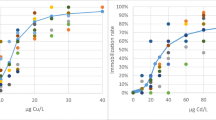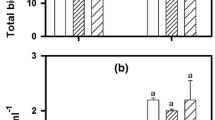Abstract
In the frame of a project which consists in modeling a laboratory microcosm under cadmium pressure, we initiated this study on the fate and effects of cadmium in the presence of either the microalga Pseudokirchneriella subcapitata or the duckweed Lemna minor, two organisms of the microcosm. For each organism, growth inhibition tests on a duration of 2–3 weeks were carried out with the objective of linking effects with total dissolved, ionic and internalized forms of cadmium. Numbers of organisms (algal cells or duckweed fronds) in 2-L beakers filled with synthetic nutritive medium containing EDTA were counted during the course of assays, while cadmium concentrations in the water and in the organisms were measured. Free cadmium fraction was calculated using PHREEQC, a computer program for chemical speciation. Results showed that cadmium toxicity to microalgae could be correlated to the free divalent fraction of this metal, limited by the presence of EDTA, and to its concentration in the organisms. Bioconcentration factors for our medium were suggested for P. subcapitata (111,000 on the basis of free cadmium concentration) and L. minor (17,812 on the basis of total dissolved concentration). No effect concentrations were roughly estimated around 400 µg/g for Pseudokirchneriella subcapitata and 200–300 µg/g for Lemna minor. This study is a first step towards a fate model based on chemical speciation for a better understanding of microcosm results.



Similar content being viewed by others
References
AFNOR (1996) Essais des eaux. Détermination de l’inhibition de la croissance de Lemna minor. XP T90–337
Andresen E, Kappel S, Stärk HJ, Riegger U, Borovec J, Mattusch J, Heinz A, Schmelzer CEH, Matoušková Š, Dickinson B, Küpper H (2016) Cadmium toxicity investigated at the physiological and biophysical levels under environmentally relevant conditions using the aquatic model plant Ceratophyllum demersum. New Phytol 210:1244–1258
Balen B, Tkalec M, Šikić S, Tolić S, Cvjetko P, Pavlica M, Vidaković-Cifrek Z (2011) Biochemical responses of Lemna minor experimentally exposed to cadmium and zinc. Ecotoxicology 20:815–826
Bertin G, Averbeck D (2006) Cadmium: cellular effects, modifications of biomolecules, modulation of DNA repair and genotoxic consequences (a review). Biochimie 88:1549–1559
Bianconi D, Pietrin F, Massacci A, Iannelli MA (2013) Uptake of Cadmium by Lemna minor, a (hyper?-) accumulator plant involved in phytoremediation applications. E3S Web of Conferences
Cairns J Jr, Cherry DS (1993) Freshwater multi-species test systems. In: Calow P (ed) Handbook of ecotoxicology, Vol. 1, Blackwell Scientific Publications, London, pp 101–116
Campbell PGC, Errécalde O, Fortin C, Hiriart-Baer VP, Vigneault B (2002) Metal bioavailability to phytoplankton—applicability of the biotic ligand model. Comp Biochem Physiol Part C 133:189–206
Castañé PM, Topalián ML, Cordero RR, Salibian A (2003) Influencia de la especiación de los metales pesados en medio acuático como determinante de su toxicidad. Rev De Toxicol 20:13–18
Charlier Jr HA, Albertson C, Thornock C, Warner L, Hurst T, Ellis R (2005) Comparison of the effects of arsenic (v), cadmium (ii), and mercury (ii) single metal and mixed metal exposure in radish, Raphanus sativus, fescue grass, festuca ovina, and duckweed, Lemna minor. Bull Environ Contam Toxicol 75:474–481
Clément B, Triffault-Bouchet G, Delhaye H (2013) Development and Optimisation of an Aquatic Laboratory Microcosm for Ecotoxicological Risk Assessment, in Christopher C Harris (ed) Microcosms: ecology, biological implications and environmental impact, Nova Science (NOVA), Series: Microbiology Research Advances, ISBN: 978-1-62618-662-0
Clément B, Triffault-Bouchet G, Delhaye H (2014) Comparison of laboratory batch and flow-through microcosm bioassays. Ecotoxicol Environ Saf 108:217–223
Delignette-Muller ML, Forfait C, Billoir E, Charles S (2011) A new perspective on the Dunnett procedure: filling the gap between NOEC/LOEC and ECx concepts. Environ Toxicol Chem 30:2888–2891
Dilba G, Bretz F, Guiard V, Hothorn LA (2004) Simultaneous confidence intervals for ratios with applications to the comparison of several treatments with a control. Methods Inf Med 43:465–469
Drost W, Matzke M, Backhaus T (2007) Heavy metal toxicity to Lemna minor: studies on the time dependence of growth inhibition and the recovery after exposure. Chemosphere 67:36–43
Echeveste P, Silva JC, Lombardi AT (2017) Cu and Cd affect distinctly the physiology of a cosmopolitan tropical freshwater phytoplankton. Ecotoxicol Environ Saf 143:228–235
Elendt BP, Bias WR (1990) Trace nutrient deficiency in Daphnia magna cultured in standard medium for toxicity testing. Effects of the optimization of culture conditions on life history parameters of D. magna. Wat Res 24:1157–1167
Errecalde O, Seidl M, Campbell PGC (1998) Influence of a low molecular weight metabolite (citrate) on the toxicity of cadmium and zinc to the unicellular green alga Selenastrum capricornutum: an exception to the free-ion model. Wat Res 32:419–429
Folgar S, Torres E, Pérez-Rama M, Cid A, Herrero C, Abalde J (2009) Dunaliella salina as marine microalga highly tolerant to but a poor remover of cadmium. J Hazard Mat 165:486–493
Gadd GM (1990) Heavy metal accumulation by bacteria and other microorganisms. Experiencia 46:834–840
Guéguen C, Koukal B, Dominik J, Pardos M (2003) Competition between alga (Pseudokirchneriella subcapitata), humic substances and EDTA for Cd and Zn control in the algal assay procedure (AAP) medium. Chemosphere 53:927–934
INERIS (2011) Cadmium et ses dérivés. Fiches de données toxicologiques et environnementales, p 82
ISO (2012) Qualité de l’eau. Essai d’inhibition de la croissance des algues d’eau douce avec des algues vertes unicellulaires, NF EN ISO 8692, p 23
Kaulbach ES, Szymanowski JES, Fein JB (2005) Surface complexation modeling of proton and cadmium adsorption onto an algal cell wall. Environ Sci Technol 39:4060–4065
Khellaf N, Zerdaoui M (2009) Growth response of the duckweed Lemna minor to heavy metal pollution. Iran J Environ Health Sci Eng 6:61–166
Koukal B, Gueguen C, Pardos M, Dominik J (2003) Influence of humic substances on the toxic effects of cadmium and zinc to the green alga Pseudokirchneriella subcapitata. Chemosphere 53:953–961
Koukal B, Rosse P, Reinhardt A, Ferrari B, Wilkinson KJ, Loizeau JL, Dominik J (2007) Effect of Pseudokirchneriella subcapitata (Chlorophyceae) exudates on metal toxicity and colloid aggregation. Wat Res 41:63–70
Kwan KHM, Smith S (1991) Some aspects of the kinetics of cadmium uptake by fronds of Lemna minor L. New Phytol 117:91–102
Lamonica D, Clément B, Charles S, Lopes C (2016) Modelling algae-duckweed interaction under chemical pressure within a laboratory microcosm. Ecotoxicol Environ Saf 128:252–265
Maloney F (2007) Influence de paramètres physico-chimiques (dureté, pH et présence d’un agent chélateur, l’EDTA) sur la réponse toxique au cadmium de l’algue verte d’eau douce Pseudokirchneriella subcapitata. Université du Québec, Canada, p 138
Naumann B, Eberius M, Appenroth KJ (2007) Growth rate based internal concentration–response relationships and EC-values of ten heavy metals using the duckweed growth inhibition test (ISO 20079) with Lemna minor L. clone. St. J Plant Physiol 164:1656–1664
OECD (1996) Bioconcentration: flow-through fish test. OECD guidelines for the testing of chemicals, No. 305E. Organization for Economic Co-Operation and Development, Paris, France, p 23
Oves M, Khan Saghir, Zaidi A (2013) Biosorption of heavy metals by Bacillus thuringiensis strain OSM29 originating from industrial effluent contaminated north Indian soil. Saudi J Biol Sci 20:121–129
Pardos M, Benninghoff C, Thomas RL (1998) Photosynthetic and population growth response of the test alga Selenastrum capricornutum Printz to zinc, cadmium and suspended sediment elutriates. J Appl Phycol 10:145–151
Park A, Kim YJ, Choi EM, Brown MT, Han T (2013) A novel bioassay using root re-growth in Lemna. Aquat Toxicol 140:415–424
Parkhurst DL, Appelo CAJ (1999) User’s guide to PHREEQC (version 2)—a computer program for speciation, batch-reaction, one-dimensional transport and inverse geochemical calculations. Water Resources Investigations Report 99–4259, Denver, Colorado
Razinger J, Dermastia M, Koce J, Zrimec A (2008) Oxidative stress in duckweed (Lemna minor L.) caused by short-term cadmium exposure. Environ Pollut 153:687–694
Rodgher S, Espindola ELG, Simoes FCF, Tonietto AE (2012) Cadmium and chromium toxicity to Pseudokirchneriella subcapitata and Microcystis aeruginosa. Braz Arch Biol Technol 55:161–169
Saygıdeğer S, Doğan M (2004) Lead and cadmium accumulation and toxicity in the presence of EDTA in Lemna minor L. and Ceratophyllum demersum L. Bull Environ Contam Toxicol 73:182–189
Schützendübel A, Schwanz P, Teichmann T, Gross K, Langenfeld-Heyser R, Godbold D, Polle A (2001) Cadmium-induced changes in antioxidative systems, hydrogen peroxide content, and differentiation in Scots pine roots. Plant Physiol 127:887–898
Singh J, Chawla G, Naqvi SHN, Viswanathan PN (1994) Combined effects of cadmium and linear alkyl benzene sulfonate on Lemna minor L. Ecotoxicology 3:59–67
Sunda WG, Huntsman SA (1998) Processes regulating cellular metal accumulation and physiological effects: phytoplankton as model systems. Sci Total Environ 219:165–181
Thellen C, Blaise C, Roy Y, Hickey C (1989) Round Robin testing with the Selenastrum capriconutum microplate toxicity assay. Hydrobiologia 188/189:259–268
Thompson PA, Couture P, Thellen C, Auclair JC (1987) Structure-function relationships for monitoring cellular stress and recovery responses with Selenastrum capricornutum. Aquat Toxicol 10:291–305
USEPA (1996) Fish BCF. US Environmental Protection Agency, Washington, DC, USA
Verheyen L, Merckx R, Smolders E (2012) Labile synthetic cadmium complexes are not bioavailable to Pseudokirchneriella subcapitata in resin buffered solutions. Aquat Toxicol 124:66–71
Wang W (1986) Toxicity tests of aquatic pollutants by using common duckweed. Environ Pollut B Chem Phys 11:1–14
Acknowledgements
The authors would like to thank the French Ministry of Ecology for funding. Many thanks also to Myriam Hammada and Thérèse Bastide for the chemical analyses, Laurent Lassabatere and Cécile Delolme for chemical modelling.
Author information
Authors and Affiliations
Corresponding author
Ethics declarations
Conflict of interest
The authors declare that they have no competing interests.
Rights and permissions
About this article
Cite this article
Clément, B., Lamonica, D. Fate, toxicity and bioconcentration of cadmium on Pseudokirchneriella subcapitata and Lemna minor in mid-term single tests. Ecotoxicology 27, 132–143 (2018). https://doi.org/10.1007/s10646-017-1879-z
Accepted:
Published:
Issue Date:
DOI: https://doi.org/10.1007/s10646-017-1879-z




